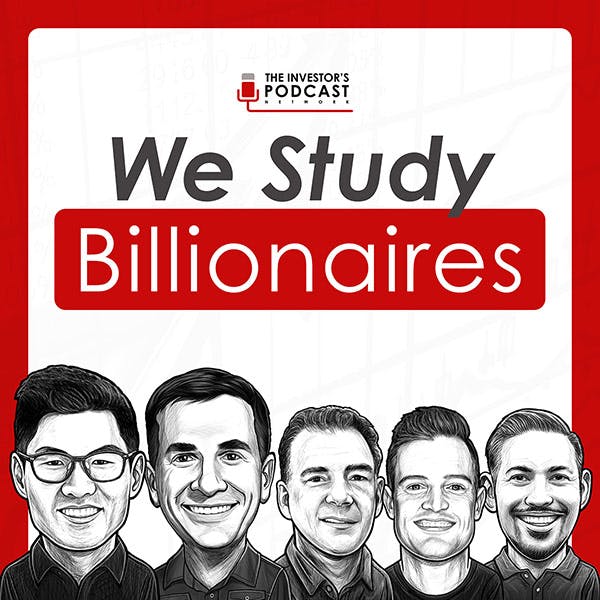
December 27, 2024 • 1hr 3min
TIP686: Big Tech Stocks w/ Adam Seessel
We Study Billionaires - The Investor’s Podcast Network

Key Takeaways
- Evolution of Value Investing: Adam Seessel describes three stages of value investing:
- Value 1.0 (Ben Graham era): Focus on balance sheets and liquidation value
- Value 2.0 (Buffett era): Focus on quality businesses with predictable growth
- Value 3.0 (Current era): Incorporating technology companies into value framework
- Tech Value Creation: Over the past 20 years, technology companies have created 55-60% of all value in the US stock market, growing from 19% to 46% of market capitalization
- Moat Analysis: Companies like Google have proven their competitive advantages by repeatedly defending against well-funded competitors like Microsoft's Bing and Amazon's A9
- Capital Intensity Trade-off: While higher capital requirements can hurt short-term profits, they can create stronger competitive barriers, as seen with Amazon's logistics network
- AI Strategy: Rather than trying to pick individual AI winners, investing in established tech platforms may be a safer way to benefit from AI and other technological trends
Introduction
Adam Seessel, founder of Gravity Capital Management and author of "Where the Money Is", joins Clay Finck to discuss his updated views on big tech companies, particularly Alphabet and Amazon, since publishing his book in 2022. Seessel shares insights from his evolution as a value investor and how he adapted his approach to succeed in the digital age.
Topics Discussed
Evolution as a Value Investor (02:50)
Adam describes his journey from journalist to Wall Street analyst to founding his own investment firm. He explains how his investment approach has evolved through three distinct periods:
- Started with traditional value investing approach in 2003
- Experienced difficulties around 2014-2016 as classic value strategies stopped working
- Transitioned to "Value 3.0" framework incorporating technology companies
Technology's Growing Market Dominance (10:58)
Seessel shares research on tech's growing share of market value:
- 2004: Tech represented 19% of US stock market value
- 2024: Tech represents 46% of US stock market value
- Value Creation: 55-60% of all value created in past 20 years came from tech sector
- "Tech is where the money is, tech is where the money is going to be"
Intrinsic Value vs Reversion to Mean (13:41)
Discussion of key investment concepts and their modern relevance:
- Reversion to Mean: No longer reliable in digital age as disrupted businesses rarely recover
- Intrinsic Value: Still valid concept based on future cash flows, but requires understanding of competitive dynamics
- Inevitability: Focus on businesses with high certainty of continued dominance
Alphabet (Google) Analysis (27:37)
Detailed discussion of Google's competitive position and current challenges:
- Search Dominance: Maintains over 90% market share despite numerous challenges
- Competitive Defense: Successfully defended against Amazon's A9 and Microsoft's Bing+ChatGPT
- Regulatory Concerns: Current DOJ proposals including Chrome divestiture and Apple search restrictions
- Scale Statistics: Processed 7.1 trillion search results in 2023
Amazon's Evolution (36:47)
Analysis of Amazon's business quality and recent performance:
- Advertising Business: Now third-largest online ad platform after Google and Facebook
- Infrastructure Investment: Successfully absorbed pandemic-era expansion
- Capital Intensity: Creates stronger competitive moat than software-only businesses
- "Amazon can publish whatever profit number it wants" due to discretionary reinvestment levels
AI Investment Strategy (47:40)
Seessel's approach to investing in AI trend:
- Platform Focus: Invest in established tech platforms rather than AI startups
- Resource Advantage: Only large tech companies have resources to fully monetize AI
- Acquisition Strategy: Major tech companies can buy or partner with successful AI startups
- "I have no AI strategy" beyond investing in companies positioned to benefit from any tech trend
Progressive Insurance Case Study (54:01)
Example of technology creating competitive advantage in traditional industry:
- Tech Investment: Better risk assessment through technology despite higher administrative costs
- Market Share Gains: Overtaken GEICO as #2 auto insurer
- Cost Advantage: Lower loss costs offset higher administrative expenses
- "Progressive is now the de facto low-cost producer of insurance"
Conclusion
The discussion highlights how traditional value investing principles can be applied to technology companies in the modern era. Seessel emphasizes the importance of adapting investment approaches while maintaining focus on business quality and competitive advantages. His analysis of Alphabet, Amazon, and Progressive demonstrates how technology creates lasting competitive advantages across different industries.









